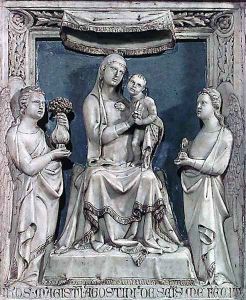Giovanni di Agostino Paintings
Giovanni di Agostino, also known as Giovanni d'Agostino or Giovanni Agostino da Siena, was an Italian sculptor and architect active during the early to mid-14th century, a period that falls within the Gothic era of art and architecture. He was born around 1310, though the exact date and place of his birth are not well documented. Giovanni was a member of a family of artists from Siena; his father was the sculptor Agostino di Giovanni, under whom he likely trained and worked.
Giovanni di Agostino is best known for his work in Siena, particularly at the Siena Cathedral, where he contributed to the sculptural and architectural elements. He is credited with the design and construction of the hexagonal pulpit in the cathedral, which is an important example of Gothic sculpture in Italy. This pulpit, however, should not be confused with the more famous pulpit in the same cathedral by Nicola Pisano and his son Giovanni Pisano, which predates Giovanni di Agostino's work.
His contributions to the Siena Cathedral also included work on the façade and the continuation of the nave. Giovanni di Agostino's style is characterized by a blend of local Sienese Gothic traditions and influences from other Italian sculptural practices of his time. His figures often display a sense of movement and emotion that was becoming more prevalent in the art of his period.
Very little is known about Giovanni's life outside of his artistic works. His career was cut short by the Black Death, which swept through Europe beginning in 1347, and it is believed that he was one of its many victims. As a result, Giovanni di Agostino's death is generally placed around the year 1347. Despite the brevity of his career, his contributions to the Siena Cathedral left a lasting impact on the artistic heritage of the region.
